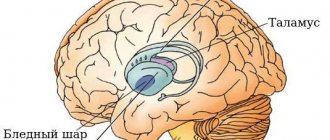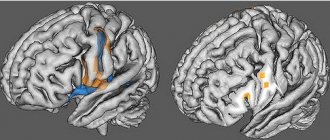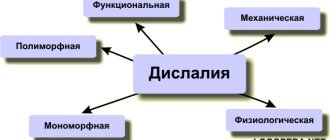Dyspraxia is a disorder of motor function and coordination of movements in a child with normal muscle tone. The deviation is associated with a violation of tactile sensations and movement planning. Often the pathology manifests itself from birth, although parents do not immediately notice it. The fact that a child has problems with articulatory motor skills is most often reported by a speech therapist after examining the child.
Experts first became aware of dyspraxia at the beginning of the last century. Initially it was called “clumsy child syndrome”, “sensory integration”, “developmental coordination disorder”, “developmental dyspraxia”. It is important not to confuse it with the term apraxia.
Main manifestations
Various degrees of dyspraxia are diagnosed in 3–6% of children, more often in boys. Many children are clumsy in early childhood, but a child with dyspraxia retains clumsiness even as an adult. Children who have been diagnosed with this disease find it difficult to perform everyday activities: they have difficulty speaking, often fall and stumble when walking, they have difficulty catching a ball in a game, maintaining balance when riding a bicycle, writing or reading something, etc. d.
Activities in which a child with dyspraxia has problems:
- speech – the work of the muscles of the articulatory apparatus is not coordinated, speech breathing is impaired;
- writing, drawing – difficulty holding a pen, brush, pencil, slow writing, long mastery of simple movements;
- reading - it is difficult to control eye movements and hold your gaze, which makes it difficult to follow the line with your eyes;
- performing basic movements when running, walking, jumping, maintaining balance;
- it is difficult to remember and reproduce the sequence of movements;
- games of high and medium mobility - children cannot catch and throw a ball, hold the attributes for the game, or use them.
Although modern medicine, and neuropathology in particular, is constantly developing innovative methods for preventing, treating and preventing disorders, dyspraxia in children is still an insufficiently studied problem.
Treatment of dyspraxia
This disease must be treated by a neurologist or osteopath. During the initial examination, the doctor evaluates the child’s coordination and motor functions and conducts a thorough examination to exclude neurological diseases, such as mild cerebral palsy. Despite the fact that dyspraxia is considered an incurable disease, timely treatment can improve a child’s behavior, school performance, reduce anxiety and all kinds of problems in the psycho-emotional sphere.
If you notice the symptoms listed above in your child, contact a neurologist or pediatric osteopath as soon as possible. All health issues must be addressed immediately.
Causes and symptoms of childhood dyspraxia
This disease can be either primary or secondary. In the first case, the causes of dyspraxia are not associated with neuropathological disorders, however, they are not easy to determine without the use of special techniques. In the second case, dyspraxia is a consequence of traumatic brain injury, cerebral palsy, other pathologies of the nervous system, or is part of the symptoms of Down syndrome, autism, and Williams syndrome.
Presumable causes of the pathology:
- Genetic predisposition - mutations of the FOXP2 gene.
- Family inheritance in a direct line, from parents.
- Pathological course of pregnancy - stressful situations, toxic effects of drugs, waste products of bacteria during viral infections, the environment, oxygen starvation of the fetus.
- Post-term or premature pregnancy.
The basis of the pathology, according to medical research, is not damage, but underdevelopment of connections between neurons. As a result, the nerve impulse arising in the cerebral cortex does not find its way to the motor system.
Symptoms of pathology may vary depending on the age of the child. In the first year of life, dyspraxia manifests itself in the form of disturbances in congenital reflexes:
- disturbances of the sucking reflex;
- problems with fixation of gaze;
- difficulty grasping objects with the palm of your hand;
- impaired coordination of movements.
In preschool age, there is increased motor activity, poor attention, difficulties with eating and maintaining balance.
Symptoms of the disorder are as follows:
- delayed development of the ability to eat and dress;
- awkwardness in movements;
- difficulty identifying the dominant hand;
- frequent falls and stumbles while walking;
- inability to catch and throw a ball, jump, stand on one leg, ride a bicycle;
- difficulties with learning to read and write;
- difficulty walking in a straight line;
- difficulty finding an answer to a simple question, although the child knows it;
- problems with long-term memory, when the child forgets the educational material studied the day before;
- inability to remember and follow complex instructions;
- difficulty determining the right and left sides;
- sleep disorders;
- sensitivity to touch.
Sometimes the pathology manifests itself only in high school age. Usually, this requires a strong emotional stimulus - excessive study load, negative attitude of peers or teachers.
In school-age children, pathology most often manifests itself in the inability to master the material. Dictations and copying are especially difficult. Children suffer from dysgraphia and dyscalculia.
All these symptoms leave an imprint on the psycho-emotional state of the child. He is unable to realize his potential because he is constantly the target of ridicule from his peers. Children become anxious, irritable, and passive. They move away from their peers and are often left alone.
Features of speech of children with verbal dyspraxia
Let's talk more about articulatory dyspraxia . This is one of the types of speech underdevelopment. The condition is characterized by impaired pronunciation function due to paralysis of the articulatory apparatus.
With dyspraxia associated with verbal disorders, the following deviations in sound speech are found:
- distortion of phonetic characteristics of sounds;
- phoneme substitutions;
- lack of automation of sounds;
- omissions of consonants and vowels;
- syllable rearrangements;
- mixing of mastered phonemes;
- lexico-grammatical violations;
- difficulty in constructing phrases and sentences.
Verbal dyspraxia differs from dysarthria and motor alalia in many ways. These diseases should not be confused, since the approach to correcting disorders is different.
Differences from dysarthria
Articulatory dyspraxia differs from dysarthria in the following ways:
- The child is looking for an articulatory position
- If the phoneme or word is familiar to the child and is automated, then he is more likely to pronounce it correctly
- The presence of errors in speech depends on pronunciation conditions. If a child repeats someone else's phrase or phoneme, he will pronounce it correctly. Under conditions of emotional excitement in speech, errors occur much more often.
Differences from motor alalia
Oral dyspraxia has the following distinctive features:
- rich vocabulary;
- correct grammatical formatting of sentences and phrases;
- relative freedom in composing texts for one’s own statements;
- the ability to play with words, such as making rhymes.
Self-diagnosis methods
It is very important to promptly draw the attention of specialists to this problem, because in preschool age the development of movements and the development of the psyche are closely related to each other. A lag in any area entails a distorted development of other personality traits. It is important to arrive at the threshold of schooling with maximum compensation for dyspraxia.
There is a simple way to initially diagnose dyspraxia that can be done at home - the jump test. You need to jump on two legs, accompanied by the count “one-two-three-four”, changing the movements of the legs in a certain sequence:
- one - legs to the sides;
- two – legs crossed (left leg in front of right);
- three – legs to the sides;
- four - legs crossed (right leg in front of left).
Signs of trouble:
- the child cannot jump according to the pattern suggested by the adult;
- he is unable to maintain the rhythm set by the score;
- crossing his legs, he turns his pelvis.
This diagnostic method is quite accurate and can be used from 4–5 years of age.
If a child has dyspraxia: types and correction
Translated from Greek “dys” means violation, “praxis” means activity. The child's inability to make consistent, purposeful movements. Articulatory dyspraxia is the inability to make consistent movements with the tongue, lips, mouth, and the inability to switch from one articulatory posture to another.
Recently, there are more and more dyspraxic children. The reason for this is the defective development of neurons in the cerebral cortex. Children cannot pronounce simple words “Ta-nya”, “Va-nya”, “Ka-tya” due to the inability to raise the tongue on the second syllable and make a series of tongue movements. Therefore, the sound pronunciation and syllable structure of the word are impaired. This violation can be corrected. The main thing is to maintain consistency in correctional work, smoothly moving from one stage to another. Correction of dyspraxia can last for more than one year with systematic sessions with a speech therapist.
Types of dyspraxia
There are two types of dyspraxia – afferent (kinesthetic) and efferent (kinetic). Afferent - the child’s inability to pronounce individual isolated sounds without switching - taking a certain position with the mouth. These are completely non-speaking children who cannot pronounce even individual sounds, with the exception of a few vowels. This form is more complex and requires a lot of work.
Efferent dyspraxia is the inability of a child to switch his mouth from sound to sound. The tongue and lips work poorly. Such a child can pronounce individual syllables, mainly stressed ones, but will have difficulty saying the simple word “Ma-nya.” He confuses, swallows syllables, speaks his own language, has porridge in his mouth - all this is a violation of the syllabic structure of the word. These two forms of dyspraxia cannot exist together.
Three types of praxis
Before starting correctional work, it is important to know that there are three types of praxis: gross motor skills, fine motor skills, and articulatory motor skills. The development of a child always begins with the body.
Gross motor skills – somatognosis, the ability to move the body. Before you teach him to speak, you need to teach him to take a particular pose. The child must jump, run away, crawl away, turn around, only then will he learn to speak. In our computer age, children often do not fully experience this stage of their own development. They have not learned to control their own body and immediately switch to using their tongue. What kind of articulatory gymnastics does he need if “physics” suffers? The child comes to learn to speak, but does not know how to throw a ball, jump on two legs, and does not control his own body. We must understand that parts of the brain develop in stages.
Next, we develop fine motor skills of the hands. This includes visual-spatial coordination: eye-hand. Will the baby be able to correctly insert objects into a narrow or round hole with his fingers, lay out a square of counting sticks according to a pattern, sort out the beans, thread a string into the hole. If he doesn’t know how, we teach him.
Articulatory praxis is the ability to switch the tongue from one position to another. Every speech sound has some form of articulation. When about to pronounce the word “cat”, our mouth is already prepared in advance to extend and round the lips for the sound [o] after playing [k]. These movements are very fast, barely noticeable, but the articulation organs must be prepared and trained for them. Articulation and clarity of pronunciation of sounds is called coarticulation.
Stages of dyspraxia correction
In correctional work, it is important to follow all stages and not jump to the next one until the previous one has been completed. If the syllable structure of a word is broken, there is no need to start working on sound pronunciation. You can combine work on three types of praxis. For example, when developing general motor skills, you can involve working with your fingers and pronouncing those syllables that are accessible to the child.
Gross motor skills
In work, everything starts with the body. If a child has poor control of his body and fingers, there is no point in moving on to the formation of articulatory praxis. At the very beginning, we teach the child to use his senses. To do this, we let him smell, touch objects, cereals, sand, plasticine, listen to sounds (like pouring water, rustling paper, ringing a bell, knocking spoons, a drum, etc.). Sensory integration is needed to improve somatognosis. This concept includes the child’s ability to move and control his own body. By the age of 4, a child should be able to jump on two legs without problems, pushing off at the same time, jump over a rope with both legs, stand on one leg, catch and throw a ball, and walk up the stairs in alternating steps. If he doesn’t know how to do this, then we begin to develop general motor skills using simple exercises as an example: repeat after me - cross your arms, clap your hands above your head, behind your back, in front of you, tap on your shoulders, on your knees. Cannot repeat body posture, cannot repeat sounds and syllables. To help your child learn to feel his body, you can touch his nose, cheek, lips and other parts of the body. With his eyes closed, he must show which part was touched. Often awkward children have disrupted behavior because they do not feel their body.
Next we work on switching from one body pose to another. They clapped, stomped, and tapped their knees. The child must be able to perform movements sequentially, not simultaneously, but each separately. You can come up with other poses: hands on the waist, up, down, etc. Any word consists of a certain sequence, so before you learn to reproduce the syllables in a word, you need to learn how to perform a series of sequential body movements.
When a child learns to control his body, he must learn to determine the distance to an object relative to himself. For example, we insert a thread into a toy needle, throw the ball up, high, low, far, close, towards ourselves, away from ourselves, to the left, to the right. We carry out the commands: step forward, backward, right, left, give the object behind you, in front of you, place the toy to your right. Then we learn to arrange objects relative to each other. The mouse is in front of the cat, to the right of the doll, behind the dog, etc. We learn to determine the location of one object relative to another (where?).
With the development of spatio-temporal relations at this stage, this includes motor planning - determining the sequence of not only objects relative to each other, but also the sequence of actions. What first and what then. To do this, we teach you how to follow simple commands: first put the blue pebble in the box, and then the red one. The child must first listen to the instructions and only then follow them. Pebbles can be replaced with any objects: toys, balls, spoons, forks. Even while dressing, you can give the following instructions: put on your jacket first, and then your hat. We gradually complicate the instructions to three steps. When performing these actions, neural connections in the cerebral cortex begin to change.
In parallel with the development of general motor skills, the development of phonemic hearing and pronunciation of syllables can be connected. To do this, the child must lay out a rhythmic series, perhaps from pebbles, multi-colored cubes, buttons, pencils: red, yellow, red - continue the series. If the sequence is followed correctly, press the index finger on the pebble. For example, red is the syllable “ta”, yellow is “nya”. “Ta-nya, ta-nya, ta-nya, ta-nya,” etc. You can take other syllables: “ma-me”, “va-ta”.
Fine motor skills
We learn to feel the fingers, master the tweezer grip (grab with the index finger and thumb). To do this, we connect clothespins, beans, beans, coffee beans and other small items (sorting, rearranging). When the child masters the tweezer grip, then he will begin to use the organs of articulation. Such a grip should be formed by 1.5-2 years. We connect visual-rhythmic rows (laying out pebbles). Simple sequence: one-one; complicate it - two-one; one two; then one-one-one. We develop an understanding that each element depends on the other, just like the syllables in a word and the articulation of each sound.
The development of fine motor skills of the hands is also necessary for any child in order to start writing in the 1st grade. If your fingers are weak, your writing will be slow and clumsy. We develop our fingers through simple exercises: we crumple paper with our palm, throw a ball, throw darts, tear paper into small pieces, roll sausages from plasticine or dough (not with our palm, but with the phalanges of our fingers). Press the plasticine with your index finger, squeeze out the toothpaste and turtle head from the sensory toy. Learning to hold a pencil: coloring, tracing, shading, writing hooks, sticks.
Working on hand switchability is so that the child can dynamically change the position of his fingers. Finger gymnastics and exercises such as “Finger-fist” are well suited for this. We use the same pebbles (rhythmic rows): press one pebble with your index finger, press the other with your fist. Finger-fist-finger-fist-finger-fist. Learn to change postures with your palms: fist-edge-palm. At the same time, we teach the child simple rhythms: tap your palms alternately on the table, on the drum, 2 times on the table, once on the drum, loudly, quietly, highlighting the stressed syllable.
It is also important to develop visual-spatial coordination: eye-hand. Hit the ball into the basket, insert the object into the desired hole, lay out a picture of matches, counting sticks, continue the row on a sheet of paper in the cells, graphic dictation. Next, as part of the development of temporal-spatial relations, we move on to working on a plane (sheet of paper). Draw a circle to the right of the square, a triangle below the circle, etc. Such orientation is important not only in terms of the development of oral speech, but also the development of writing. Since we begin to write letters from the beginning of the line, in a certain sequence in the word, without going beyond the boundaries of the line.
Treatment methods
To correct dyspraxia, modern innovative techniques using kinesiotherapy are used:
- stabilometry method with bioactive connection;
- dynamic correction with reflex-loading devices “Gravistat”, “Adelie”, “Graviton”;
- passive vestibular training using a computer stand;
- electrical stimulation of muscles;
- computer video analysis of movements;
- transcranial polarization of the brain.
Simultaneously with similar methods, pharmacological therapy with cerebroprotectors of nootropic action is used: Cytoflavin, Actovegin, Cortexin, Lecithin, Glycine, Semax, Gliatilin.
General therapeutic measures are highly effective - physical therapy, psychological and speech therapy correction. Much attention is paid to restoring the function of balance and basic movements, for which mobile and finger games and elements of sports games are used.
When treating verbal dyspraxia, the speech therapist chooses a special system of exercises for the child, one part of which is aimed at developing the pronunciation of sounds, and the second at restoring articulation.
- The first option involves teaching the child accurate articulation of phonemes. Much attention is paid to sound patterns.
- The essence of the second option is to actively train the facial muscles responsible for articulation. At the beginning of therapy, the baby imitates the elementary movements of the lips and tongue, the description of which is wrapped in a fairy tale plot (“The Tale of the Merry Tongue”). Upon completion of the correction, he must independently reproduce a sequence of several movements.
Children with dyspraxia are encouraged to participate in group gymnastics classes. They perfectly develop the vestibular apparatus, and the child gains control over his movements. Games with musical accompaniment are very useful. While playing them, children will feel the rhythm, which allows them to improve body control and coordination.









